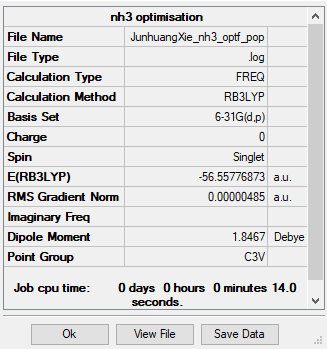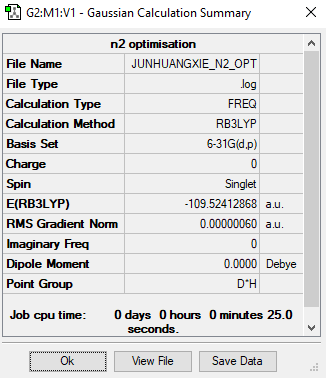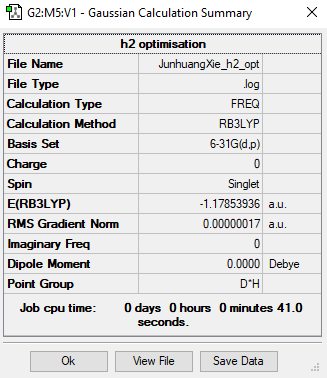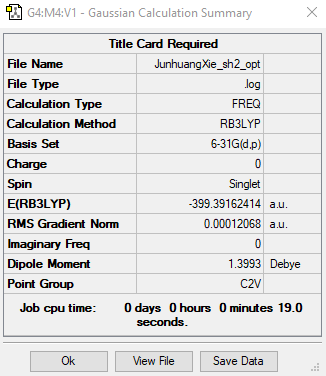Rep:Mod:xjh1123
Amonia
Key Information
Calculation method: RB3LYP
Basis set: 6-31G(d.p)
Final energy E(RB3LYP): -56.55776873 a.u.
RMS gradient norm: 0.00000485 a.u.
Point group: C3v
Geometric Information
Optimized N-H bond distance: 0.01798Å
Optimized H-N-H bond angle: 105.741°
Summary Table
Item Table
Item Value Threshold Converged? Maximum Force 0.000007 0.000450 YES RMS Force 0.000006 0.000300 YES Maximum Displacement 0.000112 0.001800 YES RMS Displacement 0.000053 0.001200 YES
Jmol Dynamic Image
test molecule |
Link to the final file of the optimisation/frequency
Vibration
3N-6 rule says: in general, a non-linear molecule with N atoms has 3N-6 normal modes of vibration. In our NH3 molecule, there are 4 atoms, so there are 3x4-6=6 vibrational modes:
| Mode number | frequency (cm-1) | Infrared |
|---|---|---|
| 1 | 1090 | 145 |
| 2 | 1694 | 14 |
| 3 | 1694 | 14 |
| 4 | 3461 | 1 |
| 5 | 3589 | 0 |
| 6 | 3589 | 0 |
Modes are degenerate when they have the same energy. In this case, mode 2 and mode 3, which have the same frequency of 1694.20 cm-1 thus the same energy, are degenerate. Both mode 5 and mode 6 have frequency of 3589.43 cm-1 so they are degenerate as well.
Mode 1, 2 and 3 are "bending" vibrations, while mode 4, 5 and 6 are "stretching" vibrations. Mode 1 is known as the "umbrella" mode.
| Wavenumber(cm-1) | Symmetry | Intensity(arbitrary units) | Image |
|---|---|---|---|
| 1090 | A1 | 145 | 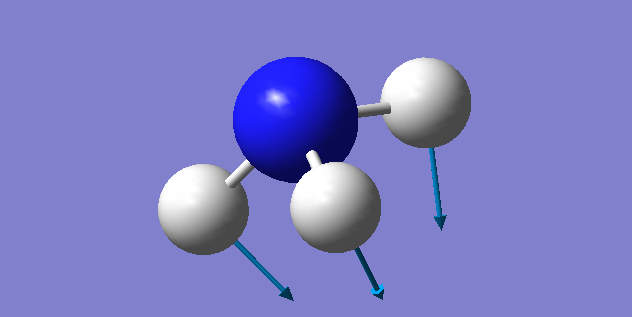
|
| 1694 | E | 14 | 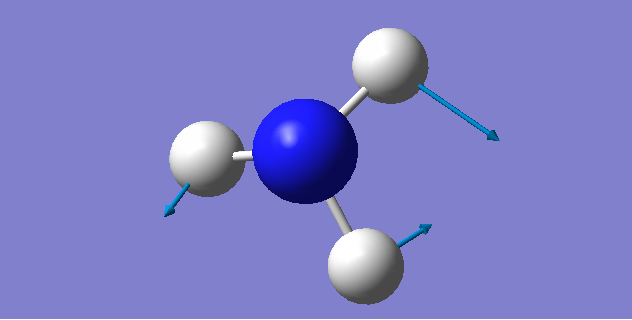
|
| 1694 | E | 14 | 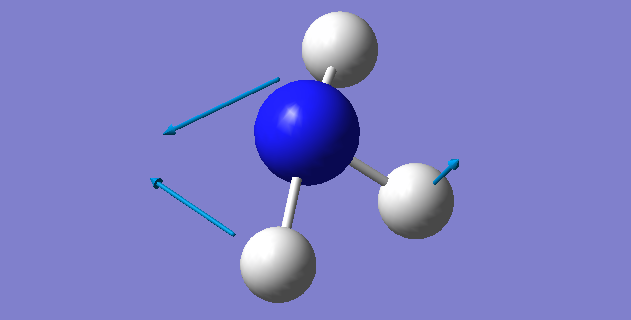
|
| 3461 | A1 | 1 | 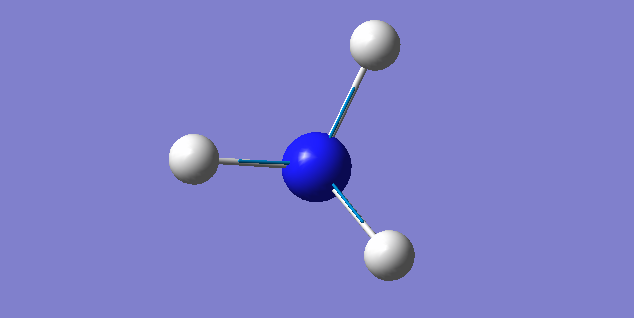
|
| 3589 | E | 0 | 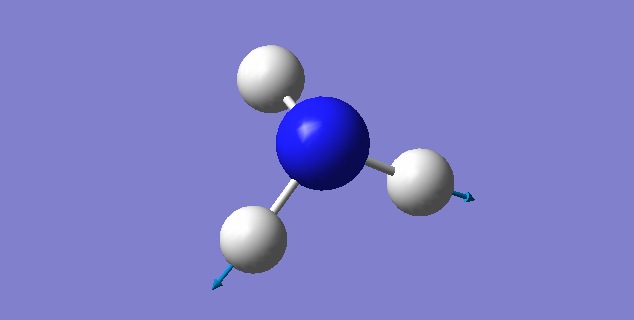
|
| 3589 | E | 0 | 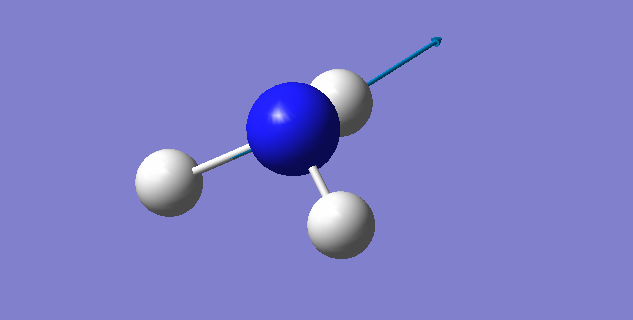
|
The Fourth mode (the mode with wavenumber 3461cm-1) is the most highly symmetric.
Experimental Spectrum
According to the table in the last section, there are 4 different wavenumbers. Although the intensities for the last two wavenumbers are round to zero, they are not completely zero. So, there is still a peak for them. Therefore, it is expected that there are totally 4 peaks in an experimental spectrum of gaseous ammonia.
Charge Distribution
Charge on nitrogen atom: -1.125
Charge on hydrogen atom: +0.375
The charge on the nitrogen atom is expected to be negative while the charge on the hydrogen atom is expected to be positive because nitrogen is much more electronegative than hydrogen.
Nitrogen
Key Information
Calculation method: RB3LYP
Basis set: 6-31G(d.p)
Final energy E(RB3LYP): -109.52412868 a.u.
RMS gradient norm: 0.00000060 a.u.
Point group: D∞h
Geometric Information
Optimized N-N bond distance: 1.10550Å
Optimized N-N bond angle: 180°
Summary Table
Item Table
Item Value Threshold Converged? Maximum Force 0.000001 0.000450 YES RMS Force 0.000001 0.000300 YES Maximum Displacement 0.000000 0.001800 YES RMS Displacement 0.000000 0.001200 YES
Jmol Dynamic Image
test molecule |
Link to the final file of the optimisation/frequency
Charge Distribution
Charge on both atoms: 0
Vibration
3N-5 rule says: in general, a linear molecule with N atoms has 3N-5 normal modes of vibration. In our N2 molecule, there are 2 atoms, so there is 3x2-5=1 vibrational mode:
| Mode number | frequency (cm-1) | Infrared |
|---|---|---|
| 1 | 2457 | 0.0000 |
Mono-metallic TM Complex
DAMSUG:
N-N bond distance in this crystal structure: 1.128(4) Å and 1.134(5) Å
Link to more information: [Link to CSD Entry: DAMSUG]
Optimised N-N distance:
1.10550Å
N-N bond distance in DAMSUG crystal structure is longer than the optimised N-N distance. Explaination is that: in DAMSUG crystal structure, one of the nitrogen in is forming four bonds, while in the gaseous nitrogen structure, there is only a triple bond. When one of the nitrogen is forming four bonds, it becomes partially positive because its lone pair is shared with the other atom (in this case, the W atom). The electrons in the triple bond would delocalised to stabilise the partially positive nitrogen atom, forming a resonant form with double bond between two nitrogen atoms. Double bond is longer than the triple bond.
Haber-Bosch Process
N2 + 3H2 → 2NH3
E(NH3)= -55.55776862 a.u.
2*E(NH3)= 2*(-55.55776862)= -111.1155372 a.u.
E(N2)= -109.52412868 a.u.
E(H2)= -1.17853936 a.u.
3*E(H2)= 3*(-1.17853936)= -3.53561808 a.u.
ΔE=2*E(NH3)-[E(N2)+3*E(H2)]= -111.1155372-[(-109.52412868)+(-3.53561808)]= +1.94420956 a.u.
Unit conversion: ΔE=+1.94420956*2625.5= +5104.5222 kJ/mol
Hydrogen
Key Information
Calculation method: RB3LYP
Basis set: 6-31G(d.p)
Final energy E(RB3LYP): -1.17853936 a.u.
RMS gradient norm: 0.00000017 a.u.
Point group: D∞h
Geometric Information
Optimized H-H bond distance: 0.74279Å
Optimized H-H bond angle: 180°
Summary Table
Item Table
Item Value Threshold Converged? Maximum Force 0.000000 0.000450 YES RMS Force 0.000000 0.000300 YES Maximum Displacement 0.000000 0.001800 YES RMS Displacement 0.000001 0.001200 YES
Jmol Dynamic Image
test molecule |
Link to the final file of the optimisation/frequency
Charge Distribution
Charge on both atoms: 0
Vibration
3N-5 rule says: in general, a linear molecule with N atoms has 3N-5 normal modes of vibration. In our H2 molecule, there are 2 atoms, so there is 3x2-5=1 vibrational mode:
| Mode number | frequency (cm-1) | Infrared |
|---|---|---|
| 1 | 4466 | 0.0000 |
Hydrogen Sulfide
Key Information
Calculation method: RB3LYP
Basis set: 6-31G(d.p)
Final energy E(RB3LYP): -399.39162414 a.u.
RMS gradient norm: 0.00012068 a.u.
Point group: C2v
Geometric Information
Optimized S-H bond distance: 1.34737Å
Optimized H-S-H bond angle: 92.681°
Summary Table
Item Table
Item Value Threshold Converged? Maximum Force 0.000175 0.000450 YES RMS Force 0.000145 0.000300 YES Maximum Displacement 0.000386 0.001800 YES RMS Displacement 0.000386 0.001200 YES
Jmol Dynamic Image
test molecule |
Link to the final file of the optimisation/frequency
Charge Distribution
Charge on sulfur atom: -0.312
Charge on hydrogen atom: +0.156
The charge on the sulfur atom is expected to be negative while the charge on the hydrogen atom is expected to be positive because sulfur is more electronegative than hydrogen.
Vibration
3N-6 rule says: in general, a non-linear molecule with N atoms has 3N-6 normal modes of vibration. In our SH2 molecule, there are 3 atoms, so there are 3x3-6=3 vibrational modes:
| Mode number | frequency (cm-1) | Infrared |
|---|---|---|
| 1 | 1224 | 5 |
| 2 | 2692 | 7 |
| 3 | 2712 | 9 |
There is no degenerate level because all three modes have different frequencies thus different energies.
Mode 1 is "bending" vibration, while mode 2 and 3 are "stretching" vibrations.
| Wavenumber(cm-1) | Symmetry | Intensity(arbitrary units) | Image |
|---|---|---|---|
| 1224 | A1 | 5 | 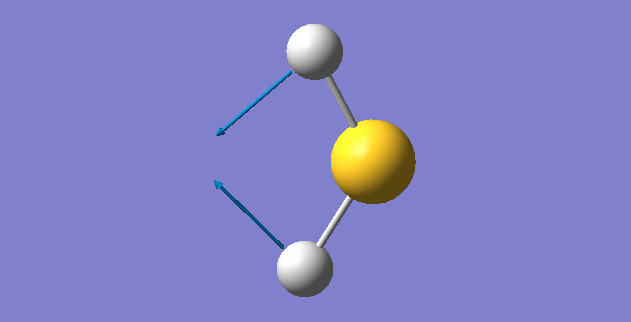
|
| 2692 | A1 | 7 | 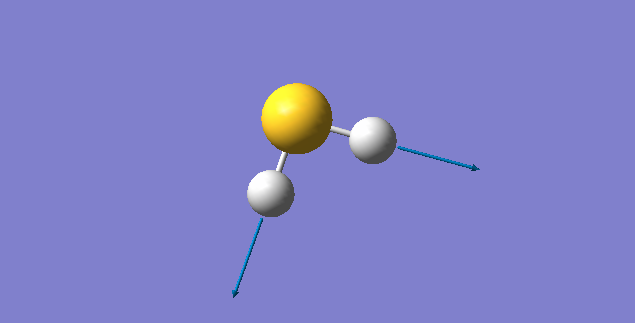
|
| 2712 | B2 | 9 | 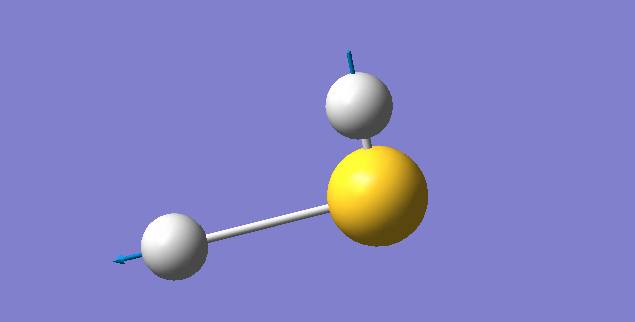
|
Molecular Orbitals
MO 2:
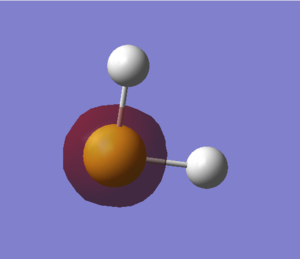
What AOs contribute to this MO?
s orbitals
Is that MO occupied or unoccupied?
Occupied
Bonding or Anti-bonding or Mixture?
Bonding orbital
What is the enrgy of this MO?
-7.95115 a.u.
Is this MO deep in energy, in the HOMO/LUMO region or High in energy?
Deep in energy
MO 6:
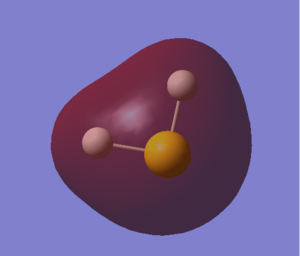
What AOs contribute to this MO?
s orbitals
Is that MO occupied or unoccupied?
Occupied
Bonding or Anti-bonding or Mixture?
Bonding orbital
What is the enrgy of this MO?
-0.74654 a.u.
Is this MO deep in energy, in the HOMO/LUMO region or High in energy?
In the HOMO/LUMO region
MO 7:
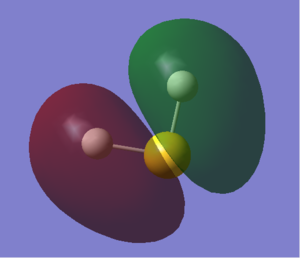
What AOs contribute to this MO?
s and p orbitals
Is that MO occupied or unoccupied?
Occupied
Bonding or Anti-bonding or Mixture?
Mixture
What is the enrgy of this MO?
-0.0.44963 a.u.
Is this MO deep in energy, in the HOMO/LUMO region or High in energy?
In the HOMO/LUMO region
MO 10:
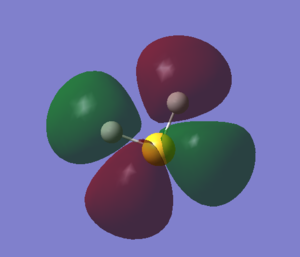
What AOs contribute to this MO?
p orbitals
Is that MO occupied or unoccupied?
Unoccupied
Bonding or Anti-bonding or Mixture?
Anti-bonding orbital
What is the enrgy of this MO?
+0.02126 a.u.
Is this MO deep in energy, in the HOMO/LUMO region or High in energy?
In the HOMO/LUMO region
MO 11:
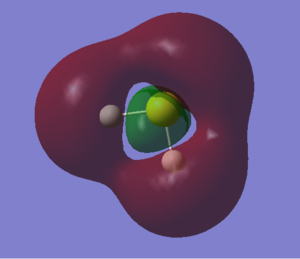
What AOs contribute to this MO?
s and p orbitals
Is that MO occupied or unoccupied?
Unoccupied
Bonding or Anti-bonding or Mixture?
Mixture
What is the enrgy of this MO?
+0.05780 a.u.
Is this MO deep in energy, in the HOMO/LUMO region or High in energy?
In the HOMO/LUMO region
Marking
Note: All grades and comments are provisional and subjecct to change until your grades are officially returned via blackboard. Please do not contact anyone about anything to do with the marking of this lab until you have recieved your grade from blackboard.
Wiki structure and presentation 1/1
Is your wiki page clear and easy to follow, with consistent formatting?
YES
Do you effectively use tables, figures and subheadings to communicate your work?
YES
NH3 1/1
Have you completed the calculation and given a link to the file?
YES
Have you included summary and item tables in your wiki?
YES
Have you included a 3d jmol file or an image of the finished structure?
YES
Have you included the bond lengths and angles asked for?
YES
Have you included the “display vibrations” table?
YES
Have you added a table to your wiki listing the wavenumber and intensity of each vibration?
YES
Did you do the optional extra of adding images of the vibrations?
YES
Have you included answers to the questions about vibrations and charges in the lab script?
YES, however due to their low intensities stretching modes are not observed in experimental spectra of gaseous NH3 which reduces the number of bands to 2.
N2 and H2 0/0.5
Have you completed the calculations and included all relevant information? (summary, item table, structural information, jmol image, vibrations and charges)
YES, you could have explained that the charges are 0 as the electronegativities are equal.
You stated a bond angle for H2 and N2. To define a bond angle a minimum of 3 atoms is needed!
Crystal structure comparison 0.5/0.5
Have you included a link to a structure from the CCDC that includes a coordinated N2 or H2 molecule?
YES
Have you compared your optimised bond distance to the crystal structure bond distance?
YES
Haber-Bosch reaction energy calculation 0/1
Have you correctly calculated the energies asked for? ΔE=2*E(NH3)-[E(N2)+3*E(H2)]
No - you extracted the correct values for the total energies of the ducts and products. However your final calculation of the reaction energy is incorrect.
Have you reported your answers to the correct number of decimal places?
NO - Energies should be reported with 1 decimal place if they are given in kJ/mol.
Do your energies have the correct +/- sign?
NO
Have you answered the question, Identify which is more stable the gaseous reactants or the ammonia product?
NO
Your choice of small molecule 3.5/5
Have you completed the calculation and included all relevant information?
YES
Have you added information about MOs and charges on atoms?
You have done a good job of presenting this information, well done! You could have included more precise information on the Mos involved in building the MOs. You identified their shape correctly correctly but information on their principal quantum numbers are missing. MO2 is a non-bonding MO since the s orbital on S does not interact with any Mos on the Hs. MO7 is not a mixture of bonding and anti bonding orbitals. The node does not make it anti-bonding at all. It is a bonding orbital.
Independence 0/1
If you have finished everything else and have spare time in the lab you could: Check one of your results against the literature, or Do an extra calculation on another small molecule, or Do some deeper analysis on your results so far
NO - no independent work was identified

